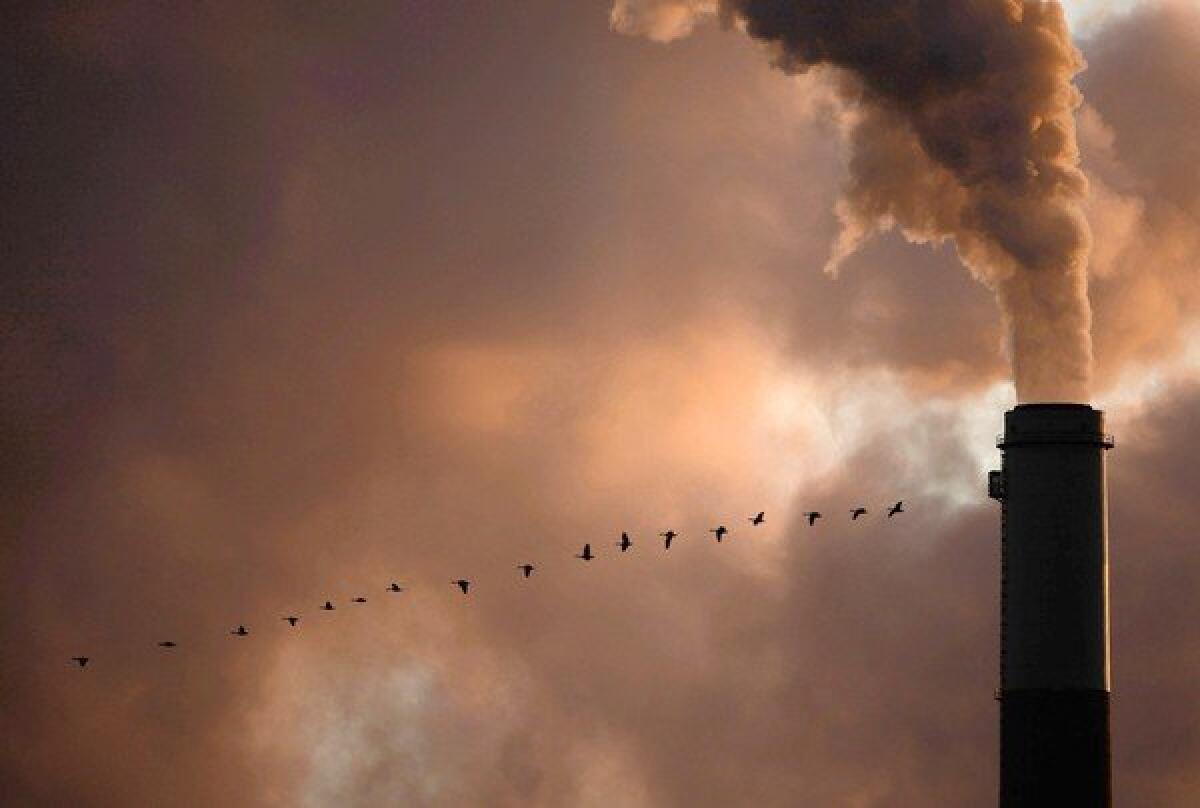Proposed power plant restrictions raise questions on more limits

- Share via
WASHINGTON — The tough restrictions on new power plant emissions proposed by the Obama administration Friday set the stage for the far thornier and significant decision due next year: What will the Environmental Protection Agency do to rein in greenhouse gases from existing power plants?
The nation’s power plants are the single largest source of heat-trapping emissions. Supporters and critics of the EPA’s proposed rule are parsing it, in particular, for clues to how the administration would reduce carbon dioxide from existing plants that burn coal, the biggest source of fuel for electricity.
The coal industry, its political allies and some businesses are already complaining that rules for existing plants would close coal-fired generators. But EPA Administrator Gina McCarthy cautioned against reading too much about the future into Friday’s announcement.
“I don’t want you to look at this proposal and say, ‘Ah, I know what the EPA is doing with existing power plants,’” McCarthy said at a breakfast meeting with reporters, environmentalists and others.
Instead, McCarthy suggested that a far more complex system might be devised to deal with existing power plants, taking into account the peculiarities of each state’s mix of power plants and their reliance on coal.
“We have to ensure that any guidance EPA puts out in 2014 translates into flexibility to account for the differences among our states and regions,” she said.
In a June speech reaffirming his commitment to battling climate change, President Obama charged the EPA with proposing rules by Friday to curtail carbon dioxide emissions from new plants and proposing rules by June 2014 for existing power plants. Coal-fired plants produce 29% of domestic greenhouse gas emissions, according to the Energy Information Administration.
“By taking common-sense action to limit carbon pollution from new power plants, we can slow the effects of climate change and fulfill our obligation to ensure a safe and healthy environment for our children,” McCarthy said. “These standards will also spark the innovation we need to build the next generation of power plants, helping grow a more sustainable clean energy economy.”
Under Friday’s proposal, for a utility to build a coal-fired plant, it would have to slash the plant’s output of carbon dioxide to 1,100 pounds per megawatt hour from the current range of 1,800 pounds to 2,200 pounds for existing plants. That kind of reduction would be achievable only through installation of carbon capture and sequestration technology, which entails scrubbing a fossil fuel before or after combustion. The coal industry and its political allies insist that the technology is too expensive. Because of this, they predict that coal plants would not be built and jobs in coal states would be eliminated.
“The president is leading a war on coal, and what that really means for Kentucky families is a war on jobs,” said Senate Minority Leader Mitch McConnell (R-Ky.). “The announcement by the EPA is another backdoor attempt by President Obama to fulfill his long-term commitment to shut down our nation’s coal mines.”
Industry and its allies have raised fears that existing plants would also face strict carbon emissions limits that would necessitate installing carbon capture equipment. On Friday, McCarthy denied that. The Clean Air Act, upon which the EPA is basing its carbon campaign, recognizes the difficulty of retrofitting facilities, said Thomas Lorenzen, a former Justice Department official on environmental issues.
The EPA regulates new facilities individually, but with existing sites, it gives guidance to the states.
“When you are dealing with an existing fleet [of power plants], it’s useful to look at it as a system,” such as on the state or regional level, said David Doniger, climate center policy director for the Natural Resources Defense Council.
The EPA is holding public and private meetings with businesses, environmentalists, utilities and state regulators before it proposes rules for existing plants, McCarthy said.
The rules for new plants may have little practical impact. Only a handful of coal plants are in the planning stages, largely due to utilities’ growing preference for cheaper, cleaner-burning natural gas.
McCarthy said that of four proposed coal plants, all plan to use carbon capture technology.
But carbon capture technology is not without problems, most notably cost. Norway shut down a carbon capture project at an oil refinery Friday because of delays and cost overruns, the BBC reported.
Some environmentalists, such as Sierra Club Executive Director Michael Brune, agree that Friday’s proposed rules would effectively bar new coal plants.
“Can you build a coal plant after this? No,” Brune said. “It’s not commercially feasible to build a new coal plant, period. When coal-burning utilities are forced to account for soot, smog, mercury and now, carbon, they can’t compete and it widens the gap between coal and other fuels.”
More to Read
Sign up for Essential California
The most important California stories and recommendations in your inbox every morning.
You may occasionally receive promotional content from the Los Angeles Times.














